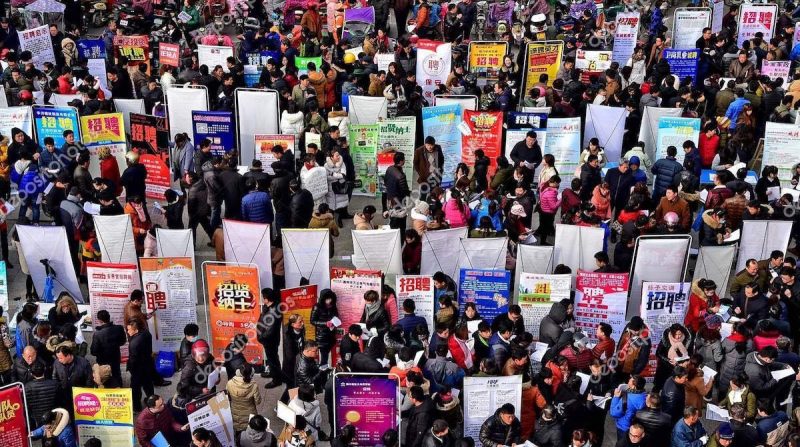Premier Li Keqiang probably has nightmares about the threat of rising unemployment in China. If he does, he would not be alone among the ruling Communist Party policy-makers.
Millions of small businesses in the world’s second-largest economy are struggling after being crippled by the Covid-19 pandemic.
“No job means no income and no wealth creation. Every effort must be made to prevent massive lay-offs,” Li has told successive executive meetings of the State Council during the past few months.
“Variations in economic growth do not matter that much, as long as employment stabilizes this year,” he repeated again last week, referring to GDP forecasts.
Putting a brake on runaway unemployment has become the overriding priority for Beijing. In February, the urban jobless rate jumped to a record-breaking 6.2% compared to 4.9% in April 2018.
But there was a valid reason for the increase. During the first two months of the year, the coronavirus epidemic scythed through the country. Businesses were closed down as up to half the 1.4 billion population suffered some form of quarantine after the outbreak in Wuhan.
“Employment remained under pressure in March as the [statistics] showed a further reduction in companies’ headcounts, though it declined at a slower rate than in February,” the Caixin China General Manufacturing Purchasing Managers’ Index revealed on Wednesday.
“The fall could be due to some employees voluntarily leaving their jobs as well as lay-offs to cut costs,” the independent survey, which tends to concentrate on the private sector and small- and medium-sized enterprises, added.
As for the hard numbers, the Caixin PMI came in at 50.1 last month compared to 40.3 in February. On Tuesday, official figures from the National Bureau of Statistics showed that manufacturing activity at large and state-owned companies jumped to 52.0 in March compared to 35.7 the previous month.
Indeed, the February figure was a historic low. Of course, PMI readings above 50 indicate expansion while those below signal contraction.
“The Caixin PMI strengthened last month from February’s abysmal levels and suggest that the contraction in activity has already bottomed out. But weak foreign demand and labor market strains will hold back the pace of recovery,” Martin Rasmussen, a China economist at research consultancy Capital Economics, said in a briefing.
Less than three weeks ago, NBS data covering industrial production forJanuary and February dropped by 13.5% for the first two months of the year. Retail sales also plunged by 20.5%. The record-breaking fall continued when it came to fixed asset investment, which plummeted by 24.5%.
To complete an appalling set of figures, profits at industrial firms during the same period slumped 38.3% from a year earlier to 410.7 billion yuan, or $58.15 billion. Moreover, that was the lowest level recorded in a decade.
Even though manufacturing is cranking up in China, overseas demand is expected to remain weak with vast swathes of the planet in lockdown.
Exports look certain to take a massive hit as Europe, the United States and the Asia-Pacific region grapple with this new coronavirus strain. In East Asia, the tremors could push 11 million more people into poverty, according to the World Bank, as the virus causes an “unprecedented global shock.”
Naturally, this will have a colossal effect on China’s industrial landscape. Huang Qifan, the vice-chairman of the National People’s CongressFinancial and Economic Affairs Committee, has warned that the fallout from the Covid-19 disease could be “scarier than the epidemic itself.”
“If measures are not taken, a large number of small and medium-sized manufacturing enterprises will fail. Just as importantly, the industrial ecology of some of the more fragile manufacturing industries will be destroyed, leading to longer-term negative effects,” Huang, the former mayor of Chongqing, wrote on the Chinese-language Sina Financewebsite.
Creating 60% of China’s GDP growth, the private sector accounts for around 80% of urban jobs and includes legions of SMEs. In a move to prop up businesses, Beijing has rolled out a raft of measures, including cutting “the reserve requirement ratio for small and medium-sized banks” so they can “offer loans to SMEs at favorable interest rates.”
Still, the risks could not be higher. Vice-Chairman Huang has also pointed to the dangers facing the vulnerable service sector. “Consumption in hotels and cinemas has fallen sharply while a large number of small- and medium-sized enterprises are under extreme pressure as a result,” he said.
“For example, China’s tourism industry contributed slightly more than 11% to GDP in 2017. The number of direct and indirect people employed in the industry exceeds 100 million. If the sector is severely hit, unemployment will rise, increasing pressure on social stability across the whole of society,” Huang added.
For Premier Li and Beijing, that is the real nightmare scenario.
























